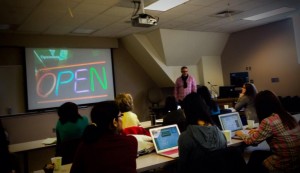Design workshops help designers communicate with clients in a way that gets beyond meeting discussions, briefs, and deliverables, extending into collaborative problem solving. It can be one of the best ways to make real issues clear and gain alignment among different stakeholders. Facilitating a workshop where clients can make their best contributions is the key to success.
After a recent design workshop I led at ASIS&T’s University of Washington Chapter, the students’ main question was how to conduct these exercises with stakeholders and clients in the real world. What changes between the classroom and the boardroom?
In Charrettes: Half Inspiration, Half Buy-In, the Nielsen/Norman Group gives a basic outline of charrette style exercises and their goals, benefits, and when to use them. Author Kara Pernice, focuses on the function for design teams and emphasizes how design workshops help team members understand each other’s roles, activities and roadblocks. When we conduct similar exercises at meetups, conferences, graduate courses and other settings, they are usually productive and well-received.
When we conduct design workshops with clients, there’s an entirely different set of challenges. Some clients react well to the format, which makes sense when you think about it; I bet you’ve met more than one person who believes they missed their design calling, no? As Pernice mentions, these exercises are a great way to unlock the potential hidden within those who don’t consider themselves designers and build buy-in early and help maintain it throughout a project.

But it’s also possible for clients to feel threatened by these exercises. Some (executives, in particular) may not be used to being asked to participate on a peer level with people who report to them. Some find the “audience-participation” aspect of charrettes intimidating. Another common refrain is that a client has hired a designer or firm to provide expertise they lack, so why are they being asked to provide ideas?
It’s a delicate balance. Knowing these questions can come up, it’s important understand your own process and expected outcomes before you start. Setting realistic goals and expectations, and conducting an exercise at the right time in the project cycle are keys to success. The focus should be on finding appropriate and innovative business solutions, not to define the ultimate design.
Find the fit: Conduct user research with your client
-
As you get to know them, watch how they behave so you can anticipate if they have a culture that’s amenable to peer collaboration or co-creation.
-
Sometimes it helps to start with a smaller group you think might enjoy it, because they’re likely to spread the word and others will want to see what all the excitement is about.
-
Make sure you invite the right stakeholders.
-
Also be sure not to exclude key influencers or decision-makers, because they may feel cut out of the process.
Here’s the Slide Share of my workshop presentation, which contains more tips.
Want to invite more collaborative design solutions in your organization? Learn more about Factor’s process or contact us.
Or share your charette and design workshop protips with us at @factorfirm.com.

